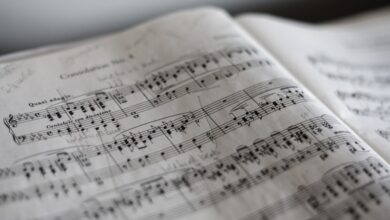Understanding the Role of Music in Religious and Spiritual Practices

Introduction:


Have you ever experienced the profound impact that music can have on your emotions and state of mind? Music has an extraordinary ability to touch our souls, and this influence becomes even more meaningful when it is intertwined with religious and spiritual practices. In this article, we will delve into the role of music in these sacred contexts, exploring how it uplifts, connects, and transforms individuals and communities.
Connecting Hearts and Minds:
Music acts as a universal language that transcends cultural and linguistic barriers, bringing people together in worship and celebration. Whether it’s the soul-stirring chants of Buddhist monks, the melodic hymns of Christian choirs, or the ecstatic drumming of indigenous rituals, music unites believers and fosters a sense of unity and belonging. It elicits a shared emotional experience, enabling individuals to connect with one another and with the divine.
Uplifting the Spirit:
Imagine stepping foot into a majestic cathedral and being enveloped by the soaring melodies of an organ. Or perhaps you’ve attended a Sufi gathering where the mesmerizing rhythms of the qawwali transport you to a heightened state of consciousness. Music possesses the power to elevate our spirits, to lift us beyond the limits of the physical realm. It touches the deepest parts of our being, evoking feelings of joy, peace, awe, and transcendence.
Expressing Devotion:
In religious and spiritual practices, music serves as a medium for expressing devotion and reverence towards the divine. Through heartfelt lyrics and enchanting melodies, believers communicate their love, gratitude, and longing for a higher power. Just as a poet uses words to convey emotions, musicians use harmonies, rhythms, and tones to articulate the ineffable aspects of their faith. They express their devotion not only through the lyrics but also through the sheer beauty and emotion embedded within the music itself.
Transformative Rituals:
Rituals involving music have the power to transform individuals on a deep level. Whether it’s through repetitive chanting, hymn singing, or ecstatic dancing, these rituals create a sacred space where participants can transcend their everyday existence and experience spiritual awakening. The rhythm and melodies guide individuals into a meditative state, enabling them to let go of their worldly concerns and connect with the divine presence within and around them.
Conclusion:
Music holds immense significance in religious and spiritual practices, serving as a conduit for connection, devotion, and transformation. Its enchanting melodies and captivating rhythms weave together communities, uplift spirits, and express the deepest longings of the human soul. Next time you find yourself immersed in a religious or spiritual gathering, pay close attention to the music being played, for it holds the power to transport you to realms of profound meaning and understanding.
Harmonizing the Divine: Exploring How Music Enhances Spiritual Experiences

Are you ready to embark on a soul-stirring journey where music and spirituality intertwine? Brace yourself as we dive into the harmonious world of divine melodies that elevate our spiritual experiences.
Have you ever wondered why certain songs have the power to move us to tears or uplift our spirits in profound ways? The connection between music and spirituality runs deep, resonating with our innermost being. When we surrender ourselves to the enchanting tunes, something magical happens. It’s as if the invisible threads of the universe come alive, weaving a tapestry of emotions and transcendence.
Music has been an integral part of religious and spiritual practices for centuries. Whether it’s Gregorian chants echoing through medieval cathedrals or devotional hymns sung in temples, the intention remains the same: to create a sacred space where seekers can connect with the divine. These melodic expressions serve as gateways to higher realms, allowing individuals to experience a profound sense of unity and transcendence.

The power of music lies in its ability to bypass the confines of language and directly touch our souls. It speaks a universal language, understood by all, regardless of culture or background. Just like a gentle breeze can sway the trees or a roaring storm can evoke awe, music has the capacity to stir our emotions and unlock hidden dimensions within us.
When we immerse ourselves in harmonious melodies, our consciousness expands, enabling us to tap into the depths of our being. The rhythmic vibrations penetrate every fiber of our being, awakening dormant energies and awakening a sense of interconnectedness with all creation. In those moments, time seems to stand still, and we become one with the music, the universe, and ourselves.
Imagine a serene lake reflecting the moonlight, each ripple creating a symphony of tranquility. Similarly, music acts as a catalyst, creating ripples in our consciousness, inviting us to explore the vast ocean of spirituality within. It awakens our dormant spirituality, reminding us of the divinity that dwells within each of us.
Sacred Sounds: Unveiling the Mystical Power of Music in Religious Rituals
In the realm of religious rituals, music holds a mystical power that transcends time and space. The enchanting melodies, rhythmic beats, and harmonious chants create an ethereal ambiance that seamlessly connects the divine with the mortal. Sacred sounds weave their way into the fabric of religious practices, touching the very core of believers and invoking profound spiritual experiences.
At the heart of these sacred sounds lies a captivating principle: the ability to evoke emotion and stir the soul. Music possesses an astounding capacity to bypass the rational mind and speak directly to our deepest emotions. It resonates within us, igniting feelings of joy, awe, devotion, or introspection. Whether it is the soothing strains of a Gregorian chant, the exuberant rhythms of African drums, or the melodic recitation of ancient hymns, each musical tradition has its unique way of engaging the human spirit.
Moreover, music acts as a powerful vehicle for communal worship and unity. When people gather in religious ceremonies, the collective voices and instruments blend together, forming a harmonious symphony of faith. This shared experience creates a sense of belonging, reinforcing the bonds between individuals and their shared beliefs. In this context, music becomes a unifying force that bridges the gaps between cultures, languages, and backgrounds, fostering a profound sense of togetherness.
Beyond its emotional and social impact, music also serves as a conduit for transcendence. The repetitive patterns, mesmerizing melodies, and hypnotic rhythms found in religious music induce altered states of consciousness. They transport the listeners to a realm beyond the physical, enabling them to connect with the divine on a deeper level. Through music, worshippers can enter a trance-like state, where the boundaries between the self and the sacred dissolve, allowing for an intimate communion with the divine.

The power of music in religious rituals is undeniable. Its ability to evoke emotions, foster unity, and facilitate transcendence makes it an indispensable element in the spiritual journey of believers across the globe. Whether it is the peaceful ambiance of a Buddhist chant or the grandeur of a majestic organ piece in a cathedral, sacred sounds have the remarkable capacity to transport us to higher realms and touch our souls in profound ways. So let us embrace the enchanting melodies of religious music and embark on a transformative voyage towards the mystical depths of the human spirit.
From Hymns to Chants: Tracing the Evolution of Sacred Music Across Religions
Introduction:
Have you ever wondered about the power of music in religious rituals? The harmonious melodies and captivating rhythms have the ability to transport us to a realm beyond our everyday experiences. In this article, we will embark on a fascinating journey, tracing the evolution of sacred music across various religions. From ancient hymns to enchanting chants, these musical expressions have played a pivotal role in spiritual practices throughout history.
The Mesmerizing World of Hymns:
Hymns, the earliest form of sacred music, hold a special place in Christianity. These melodic prayers, often accompanied by organ or choir, uplift the spirits of worshippers. Dating back centuries, they have been sung in churches worldwide, conveying messages of faith, joy, and gratitude. Through hymns, believers join their voices in unison, creating a powerful sense of unity and devotion.
Chants: A Gateway to Serenity:
In contrast to the melodic richness of hymns, chants offer a different enchantment. Found in many Eastern religions such as Buddhism and Hinduism, chanting involves repetitive recitation of sacred verses or mantras. The rhythmic patterns and soothing tones induce a meditative state, calming the mind and fostering spiritual introspection. Chanting is not limited to words; sometimes, it consists of syllables or even nonsensical sounds that transcend linguistic barriers and connect individuals to the divine.
Diving into Diversity:
As we delve deeper into the world of sacred music, we discover a rich tapestry of diversity across religions. Islam embraces the mesmerizing art of calligraphy, intricately combining written texts from the Quran with melodic recitation known as Qira’at. Judaism celebrates its heritage through psalms and liturgical melodies, expressing praise, lamentation, and celebration. In Sikhism, Kirtan—a devotional singing of hymns from the Guru Granth Sahib—captures the essence of devotion and spiritual enlightenment.
Evolution in Contemporary Context:
Sacred music continues to evolve alongside modern sensibilities. Churches incorporate contemporary styles, blending traditional hymns with contemporary Christian music genres like gospel and worship. Similarly, temples, mosques, and synagogues are embracing diverse musical influences to engage worshippers of different generations and cultural backgrounds, fostering a sense of inclusivity and relevance.
Conclusion:
The evolution of sacred music across religions is a testament to its enduring significance in human spirituality. From ancient hymns to mesmerizing chants, these musical expressions resonate deeply within individuals and communities, fostering a connection with the divine. As we embrace diversity and adapt to changing times, sacred music will continue to inspire, uplift, and unite us in our shared quest for meaning and transcendence.
Sonic Sanctuaries: Investigating the Healing Effects of Music in Spiritual Settings
Have you ever experienced a profound sense of peace and tranquility while listening to music in a spiritual setting? The intertwining of music and spirituality has long been recognized as a powerful force that can uplift the soul and touch us on a deep level. In this article, we delve into the fascinating world of sonic sanctuaries and investigate the healing effects of music in these sacred spaces.
When we step into a spiritual sanctuary, whether it’s a church, temple, or mosque, we enter a space infused with centuries of devotion and reverence. These hallowed grounds are often adorned with exquisite architecture, symbolizing the divine and providing a conducive atmosphere for worship and reflection. However, it is the ethereal melodies and harmonies that truly elevate the experience.
Music has the remarkable ability to transport us beyond the confines of our everyday lives and connect us to something greater than ourselves. It can evoke a wide range of emotions, from joy and ecstasy to contemplation and solace. In spiritual settings, music serves as a bridge between the earthly and the divine, creating an environment where the sacred becomes tangible.
The healing power of music lies in its ability to resonate with our souls and touch the depths of our being. Scientific studies have shown that listening to soothing melodies can reduce stress levels, lower blood pressure, and even alleviate pain. In spiritual contexts, music takes on an added dimension, acting as a catalyst for spiritual growth and transformation.
Just as different spiritual traditions have their unique rituals and practices, the music found in these settings also varies greatly. Gregorian chants, Hindu bhajans, Islamic call to prayer, and Buddhist hymns are just a few examples of the diverse musical expressions that accompany spiritual worship. Each tradition carries its distinct musical language, but they all share the common goal of connecting with the divine.
Sonic sanctuaries offer a space where music and spirituality harmoniously merge, creating an environment that nurtures and heals the human spirit. The enchanting melodies and sacred sounds that reverberate within these hallowed halls have a profound impact on our well-being, offering solace, inspiration, and a deeper connection to the divine. So, the next time you find yourself in a spiritual setting, allow the music to transport you to a place of inner peace and serenity.




